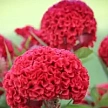
Celosia
Cock scallop
| Latin name | Celosia |
| Alternative name | Cockscomb |
| Homeland | America, Asia and Africa |
| Family | Amaranthaceae |
| Cultivation | simple |
| Location | very well lit |
| Temperature | optimal 18 °C |
| Watering | regular, non-abundant |
| Flowering time | late spring-early autumn |
| Height | up to 1.0 m |
| Transplanting | not performed |
| Appearance maintenance | remove yellowed leaves |
The genus Celosia includes more than 60 species - most often annual thermophilic herbaceous plants, especially valued for their yellow or red flowers. Only two annual species are widely distributed. Celosia silvery comb, or cock scallop (Celosia argentea f. cristata), has broad-lanceolate green or bronze leaves; the stems reach 50 cm in height and form a bush. The flowers are small and numerous, densely arranged on an overgrown peduncle resembling a cock's comb. The color of the flowers is diverse: yellow, salmon, red, purple, etc. Flowers bloom from June to September. There are low-growing garden forms (20-25 cm) grown in pots. In another species - Celosia silvery pinnate (Celosia ar gentea f. plumosa) (the so-called pinnate amaranth) - ovate or lanceolate leaves and large paniculate inflorescences of the same colors as the previous species. They grow to a height of 30-40 cm. Flowers bloom from June to August. There are also tall varieties (80-100 cm).
The genus Celosia includes more than 60 species - most often annual thermophilic herbaceous plants, especially valued for their yellow or red flowers.
Only two annual species are widely distributed. Celosia silvery comb, or cock scallop (Celosia argentea f. cristata), has broad-lanceolate green or bronze leaves; the stems reach 50 cm in height and form a bush. The flowers are small and numerous, densely arranged on an overgrown peduncle resembling a cock's comb. The color of the flowers is diverse: yellow, salmon, red, purple, etc.
Flowers bloom from June to September.
There are low-growing garden forms (20-25 cm) grown in pots.
In another species - Celosia silvery pinnate (Celosia ar gentea f. plumosa)
(the so-called pinnate amaranth) - ovate or lanceolate leaves and large paniculate inflorescences of the same colors as the previous species. They grow to a height of 30-40 cm.
Flowers bloom from June to August. There are also tall varieties (80-100 cm).
Cultivation
Celosia is grown as a flowering annual houseplant and outdoors in flower beds, flower beds and borders, and finally for winter bouquets. Containers use well-drained potting soil. In the garden, the soil should be fertile, permeable, non-acidic. Plants grown in containers or cups are recommended to be planted in the open ground after the end of frost. When planting, apply a complex fertilizer with a prolonged action of nutrients in the amount of 20 g per bucket of soil. Once every 2 weeks, a liquid fertilizer for flowering plants is added to the water for irrigation. Celosia does not tolerate stagnation of water.
Celosia is grown as a flowering annual houseplant and outdoors in flower beds, flower beds and borders, and finally for winter bouquets. Containers use well-drained potting soil.
In the garden, the soil should be fertile, permeable, non-acidic. Plants grown in containers or cups are recommended to be planted in the open ground after the end of frost.
When planting, apply a complex fertilizer with a prolonged action of nutrients in the amount of 20 g per bucket of soil. Once every 2 weeks, a liquid fertilizer for flowering plants is added to the water for irrigation. Celosia does not tolerate stagnation of water.
Location
These plants require a very well-lit area, but not in direct sunlight.
Temperature
At home, the optimal temperature is approximately 18 °C. The minimum temperature should not be lower than 14 °C. In summer, if the temperature exceeds 25 °C, it is necessary to ventilate the room. In the open air, the plant tolerates higher temperatures well.
Watering
This plant is particularly afraid of excessive watering, so it is watered only to keep the soil slightly moist. In the summer months, it is recommended to maintain high humidity by spraying the plant, pot and surrounding air with water so that water does not get on the flowers.
Care
Remove damaged and yellowed leaves.
Reproduction
Propagate by seed. Sowing - in February, in well-drained soil at a temperature not lower than 15 °C. When the shoots grow up, they dive one at a time into pots. Water very carefully. Plants grown in the fresh air can be planted finally in April-May. You can also sow seeds directly into the ground when there is no longer any danger of frost.
Diseases
Aphids infect leaves and shoots, and they get rid of pests by chemical treatment. Excessive humidity or poorly drained soil can cause rotting of plants. In this case, reduce watering. If the pH (acidity index) of the soil substrate is greater than 7.0-7.5, then there is a high probability of chlorosis due to a lack of iron. Treat the plant with iron chelate.
Acquisition
Celosia can be easily found in late spring and throughout the summer in flower shops, gardening centers, and even supermarkets. Choose plants with buds. In late winter and early spring, you can also buy seeds.